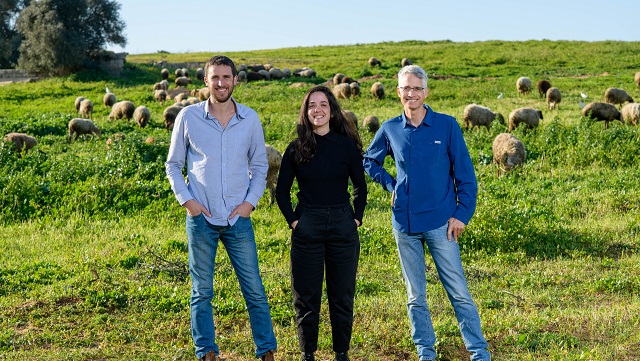
(l-r) Eyal Krieger, Lior Greenspoon and Prof. Ron Milo, together with woolier biomass contributors – Weizmann Institute of Science
A new study conducted by the Weizmann Institute of Science shows that wild land mammals weigh less than 10 percent of the combined weight of humans and are outweighed by cattle and other domesticated mammals by a factor of 30. This comes as little surprise to anyone who has followed the food industry in recent years, or who has seen documentaries like “Supersize Me” or read books like “Fast Food Nation.”
We have known for years that cattle, chickens and other farm animals have been bread to be much larger than their natural sizes. Just look at pictures of such animals from 100 years ago and compare them to how they look today. This is why milk cows are so big now and must be milked three times a day or they could die.
Not only are the animals bred to be bigger, but they are also “fattened up” with specially developed animal feed.
Will you offer us a hand? Every gift, regardless of size, fuels our future.
Your critical contribution enables us to maintain our independence from shareholders or wealthy owners, allowing us to keep up reporting without bias. It means we can continue to make Jewish Business News available to everyone.
You can support us for as little as $1 via PayPal at office@jewishbusinessnews.com.
Thank you.
And things have changed so much that the combined weight of farm animals is now greater than all of the rest in the world.
The researchers from the Weizmann Institute of Science say that this first global census of wild mammal biomass reveals the extent to which our natural world – along with its most iconic animals – is a vanishing one.
The new report shows that the biomass of wild mammals on land and at sea is dwarfed by the combined weight of cattle, pigs, sheep and other domesticated mammals. A team headed by Prof. Ron Milo found that the biomass of livestock has reached about 630 million tons – 30 times the weight of all wild terrestrial mammals (approximately 20 million tons) and 15 times that of wild marine mammals (40 million tons).
An earlier, widely-discussed study by researchers in Milo’s lab in Weizmann’s Plant and Environmental Sciences Department showed that in 2020, the mass of human-made objects – anything from skyscrapers to newspapers – had surpassed the planet’s entire biomass, from redwood trees to honeybees. In the latest study, the researchers offer a new perspective on humanity’s rapidly increasing impact on our planet, seen in the ratio between humans and domesticated mammals, and wild mammals.
“This study is an attempt to see the bigger picture,” says Milo. “The dazzling diversity of various mammal species may obscure the dramatic changes affecting our planet. But the global distribution of biomass reveals quantifiable evidence of a reality that can be difficult to grasp otherwise: It lays bare the dominance of humanity and its livestock over the far smaller populations of remaining wild mammals.”
The analysis showed that human influence also strongly affects the relatively limited remaining mammalian presence in nature. Many of the wild mammals at the top of the biomass chart, such as the white-tailed deer and wild boar species, got there partly owing to human activity and are now seen as pests in some areas.
The new study’s estimates of biomass ratios may help to monitor wild mammal populations globally and to assist in evaluating the risk posed by diseases that spread from animals to humans – a dynamic that many epidemiologists warn will continue to generate epidemics.
Mammal Numbers:
The combined weight (biomass) of humans is 390 million tons.
The livestock biomass is 630 million tons, dominated by cattle, at 420 million tons.
The biomass of wild land mammals is 20 million tons.
Ten species account for about 40 percent of the biomass of all wild land mammals.
White-tailed deer, known to many from the animated Disney movie Bambi, have the largest biomass of all wild land mammals, followed by wild boar and African elephants.
The biomass of pigs alone is nearly double that of all wild land mammals.
Domestic dogs’ biomass equals that of all wild land mammals combined.
The biomass of marine mammals is 40 million tons.
Fin whales have the largest biomass of all marine mammals. Sperm whales and humpbacks hold the second and third slots, respectively.
Biomass studies offer a different perspective on the animal world compared to other metrics. For instance, the 1,200 species of bats account for a fifth of all land mammal species and two-thirds of all wild mammals by head count (total number of individuals). However, they make up only 10 percent of the biomass of wild land mammals.
Prof. Ron Milo is head of the Mary and Tom Beck Canadian Center for Alternative Energy Research; his research is supported by the Schwartz Reisman Collaborative Science Program; the Ullmann Family Foundation and the Yotam Project. Prof. Milo is the incumbent of the Charles and Louise Gartner Professorial Chair.



